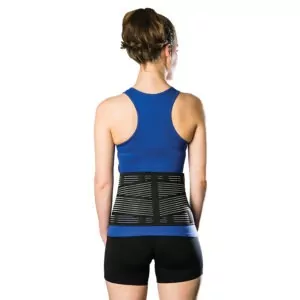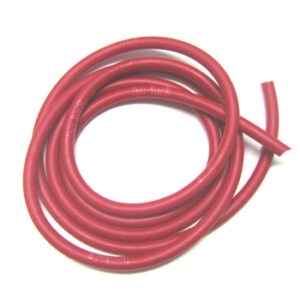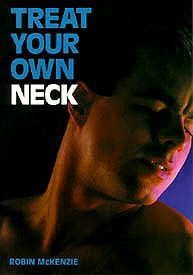Diagnostic Guide – Buttock Pain
Updated:
Pain in the buttock region is a common clinical presentation particularly in individuals with associated lower back pain or stiffness. In athletes, buttock pain is most common in sprinting or kicking sports. Symptoms may present suddenly due to a specific incident or gradually over time and may arise from local structures or be referred from the spine or sacroiliac joints.
The most common cause of sudden or gradual onset pain in the buttock region is referred pain from the lower back. This may be due to activities such as repetitive, prolonged or forceful bending, lifting, twisting or sitting and may sometimes present as buttock pain upon waking in the morning following these activities. In these instances, damage to the joints of the lower back are common such as a lumbar disc bulge or facet joint sprain.
There are numerous other causes of buttock pain, some of which present suddenly due to a specific incident, others which develop gradually over time.
Below are some of the more common causes of pain in the buttock region with a brief description of each condition to aid diagnosis. Find out what may be causing your buttock pain:
Sudden Onset Buttock Pain – Common Injuries
Referred Pain
Pain referred into the buttock from another source such as the lower back or sacroiliac joint, often associated with symptoms above or below the buttock (such as lower back pain or stiffness or pain in the thigh, lower leg, ankle or foot). Typically associated with pain on firmly touching the region responsible for the referred pain and often reduced range of movement in that region. Sometimes in association with pins and needles or numbness in the affected leg or foot.
Less Common Sudden Onset Injuries
Gluteal Strain
Sudden onset pain in the buttock / gluteal region (figure 1) due to tearing of one or more gluteal muscles, usually due to a specific incident (e.g. explosive sprinting, jumping, squatting or lunging). A pulling or tearing sensation may be experienced during injury and there is typically tenderness on firmly touching the affected muscle. Pain or stiffness may also be experienced when performing a lunge (figure 2) and / or gluteal stretch (figure 3). Swelling and bruising may also be present.

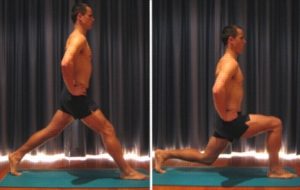
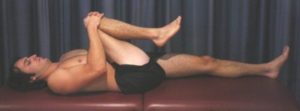
Avulsion Fracture of the Ischial Tuberosity
Fracture of the bony process of the pelvis known as the ischial tuberosity (figure 4) or ‘sitting bone’ primarily in children or adolescents. Usually arising from a specific incident such as during sprinting and associated with significant pain and disability, pain on firmly touching the affected bone and often pain during sitting.
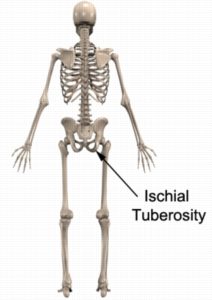
Gradual Onset Buttock Pain – Common Injuries

Members Only ContentBecome a PhysioAdvisor Member to gain full access to this exclusive content. For more details see Become a Member. Already a member? Login Now
Less Common Gradual Onset Injuries

Members Only ContentBecome a PhysioAdvisor Member to gain full access to this exclusive content. For more details see Become a Member. Already a member? Login Now
Diagnosis of buttock pain
A thorough subjective and objective examination from a physiotherapist is usually sufficient to diagnose the cause of buttock pain. Investigations such as an X-ray, ultrasound, MRI, CT scan or bones scan are often required to confirm diagnosis and rule out other injuries.
Find a Physio
Find a physiotherapist in your local area who can diagnose and treat patients suffering from pain in the buttock region.
More Information
- View Gluteal Stretches.
- View Gluteal Strengthening Exercises.
- View Hip Stretches.
- View Hip Strengthening Exercises.
- View Balance Exercises.
- View detailed information on initial injury management and the R.I.C.E Regime.
- View detailed information on How to use Crutches.
- View detailed information on when to use Ice or Heat?.
- View a Return to Running Program
Physiotherapy products for buttock pain
To purchase physiotherapy products to assist with rehabilitation click on one of the above links or visit the PhysioAdvisor Shop.

Link to this Page
If you would like to link to this article on your website, simply copy the code below and add it to your page:
<a href="https://physioadvisor.com.au/injuries/buttock”>Diagnostic Guide – Buttock Pain – PhysioAdvisor.com</a><br/>PhysioAdvisor offers a detailed buttock injury diagnosis guide created by experienced physiotherapists. Find out what is causing your buttock pain.
Return to the top of Diagnostic Guide – Buttock Pain.

